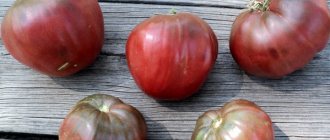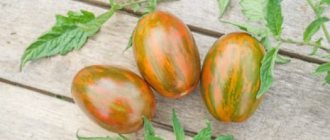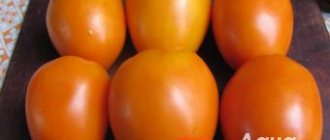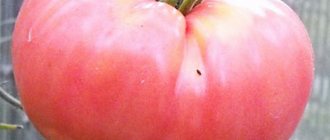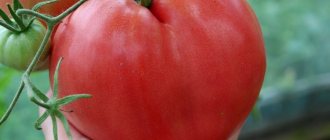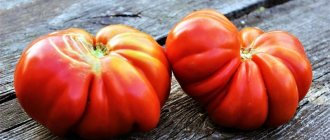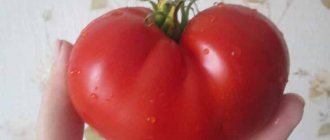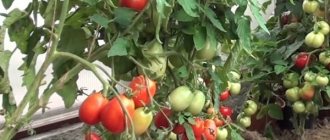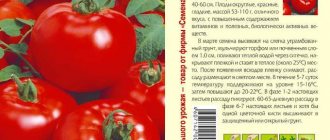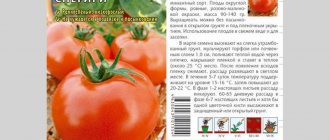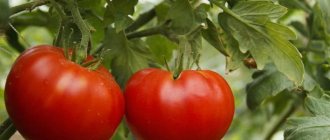Advantages and disadvantages of the variety
Like all varietal vegetable crops, the Oxheart tomato has its pros and cons.
The advantages include:
- large fruit;
- attractive appearance of the fruit;
- excellent taste;
- high yield (with proper care and suitable growing conditions);
- suitable for cultivation both in open ground and in greenhouses;
- good resistance to various diseases (which is very important for late-ripening varieties).
Flaws:
- the plant is highly demanding in care;
- long ripening period (which is not suitable for all regions);
- low resistance to temperature changes;
- short shelf life of ripe fruits.
Productivity
When growing tomatoes in open ground, the yield is about 5-7 kg per bush. In greenhouse conditions, this figure increases to 10-11 kg per plant. Fruit ripening occurs in the month of August, just during the height of late blight.
To obtain a high yield, it is very important to pay special attention to the prevention of this disease. Ripe fruits need to be picked from the bush on time. Although these tomatoes do not crack during ripening, they are quite heavy and can break branches.
Features of cultivation and care
For seedlings, tomato seeds are sown 55-60 days before the expected date of planting in a permanent place. Before planting, the seed material is soaked in a growth stimulator and treated with a biofungicide. Select a suitable container and fill it with fertile soil.
The seeds are laid out on the surface of the soil, sprinkled with a mixture of peat and soil (thickness no more than 1-1.5 cm). Moisten with warm, settled water and cover with film. Transfer to a warm (+25°C) and dark place until the seeds hatch.
When the first shoots appear, the film is removed. Containers with plantings are moved to a cooler place (+17°C) and provided with long daylight hours (at least 12-14 hours a day). If there is a lack of daylight, plants are illuminated with lamps. Water the seedlings as the top layer of soil dries.
At the stage of 2-3 true leaves, the seedlings are planted in separate cups. At this stage, maintain the temperature around +20-+22°C. Once every two weeks, seedlings are fed with liquid complex fertilizers. 7-10 days before transplanting to a permanent place, the seedlings are hardened off.
Tomatoes of the Ox's Heart variety grow well in light, fertile and sufficiently aerated soil.
The seedlings are planted in the garden bed in the phase of 6-8 true leaves, approximately 55-60 days from the moment the seeds are sowed. Planting scheme – no more than 3-4 plants per 1 sq. m. Planted seedlings are watered abundantly and mulched. Any organic material can be used as mulch.
In cloudy and rainy weather, plants are watered once every 5-7 days. During drought periods, you need to water more often - every 2-3 days. Water at the roots in the evening.
The bush is formed into 1-2 stems. To ensure that the fruits on the upper clusters do not become smaller and have time to ripen before the cold weather, no more than 6-7 flower clusters are left on the bushes and the stepsons are regularly removed.
Plants are fed every 2-3 weeks. It is best to use organic fertilizers.
Regularly loosen and weed the rows, remove weeds, as well as limp and dry leaves. The ground around the bushes and between the rows is covered with a layer of mulch.
Subject to the rules of agricultural technology and crop rotation, the Ox Heart variety is resistant to diseases. However, blossom end rot and late blight can occur on tomatoes. For prevention, plants are treated with phytosporin and calcium nitrate.
When grown in greenhouse conditions, it is necessary to arrange daily through ventilation.
Landing technology
There is nothing particularly complicated, you just need to follow certain rules recommended for growing tomatoes. Even a novice vegetable grower can cope with agrotechnical techniques.
Growing seedlings
The procedure should begin at the end of February - beginning of March. Before sowing seeds into the ground, soak them overnight in a weak solution of potassium permanganate. Pre-prepare containers, soil and lids with which you will cover the planted material.
- Make the soil from garden soil, add equal parts of wood ash and a small amount of bird droppings. The soil must be loose, light and nutritious.
- In order for the seeds to hatch faster, they need to be carefully placed on a damp cloth at some distance from each other. Cover the top with a loose layer of cloth, close the lid loosely and put it in a dark and warm place. Don't forget to ventilate regularly. In a few days the seeds will hatch.
- Replant them in a container. Moisten the soil well, compact it a little and place the seeds using tweezers. Sprinkle fertile soil on top. The layer thickness should be about 1 cm.
- Cover the container with film and place in a warm place. The air temperature should be + 23 - 24 degrees Celsius. If the room is cold, the seedlings will stop growing. It is necessary to ensure that condensation does not form on the film. If you notice droplets, remove the film and ventilate. But you can’t overdry the soil either. Tomatoes love moisture, so water them, but sparingly.
How to buy ready-made seedlings
Sometimes there is simply no time or opportunity to germinate seeds, but seedlings are needed. You can buy ready-made ones, but you should learn to figure out which sprouts are of really good quality and will then turn into healthy and strong plants.
- The stem should not be too fleshy and thick, about the size of a pencil. When the seedlings look too tall, with a lot of leaves, it means they were well fed with nitrogen before selling. The green mass will develop well, but the fruits will be too small.
- There should be only 8 - 10 leaves on the stem, all of them are green, fresh and healthy. Do not purchase seedlings with yellow leaves, because they may no longer develop properly.
- There must be a flower brush on each sprout. But if there are ovaries and fruits, then you should not purchase them, since they are unlikely to ripen; the bush will still need to take root in a new place.
- There is no need to buy seedlings that grow very closely in a container. When replanting, you can damage the root system and lose plants.
Diving and feeding
When each stem has at least 2 adult leaves, they need to be planted in separate containers. Over the course of several months, the picked seedlings will develop further.
- It is very important that young plants receive enough sun and heat. The temperature in the room should be +23 - 24 degrees during the daytime, and at least +18 at night.
- If there is not enough light, arrange additional lighting using fluorescent or incandescent lamps.
Read also: Nitroammofosk fertilizer: instructions for use in the garden
Planting in open ground
If you plan to grow Oxheart in a greenhouse, then the seedlings do not need to be hardened off first. And before planting in open ground, young plants are gradually accustomed to fresh air. First, you should take out the containers for just a few hours, then increase the time to a whole day; you can expose the bushes to the sun for a short time.
- Plant in the second half of May or early June, when the weather is finally warm and there are no residual frosts at night. At that time, the seedlings should be at least 60 - 65 days old, with at least 6 - 7 adult leaves.
- Clear the area of debris and weeds, dig up and apply mineral fertilizers and humus. It is advisable to do this in the fall. Bushes are planted in a heated greenhouse in April; if the greenhouse is not heated, then in early May.
- Since the plant is large, the gap between plants should be 50x70 cm. No more than 4 bushes should be planted per 1 m2. The root system and above-ground parts need space and air.
- If the region is cold, then the planting depth should be at least 20 - 25 cm. Add a weak solution of bird droppings or mullein to each planting hole.
- If the seedlings have stretched out, you can plant them at a slight angle. In this way, additional roots are formed, which will provide the plant with additional nutrition.
It is advisable to tie up bushes early, even if they are small. It is important to give the plant the right direction. The leaves of this variety, including the lower ones, do not need to be removed.
Water as the soil dries, but remember that tomatoes love moisture. Be sure to loosen the soil and remove weeds. Inspect your plants regularly to keep pests out.
Apply fertilizers, before flowering and fruit set, with potassium-phosphorus and a little nitrogen. Also, this variety needs to be treated with boric acid: before the flower clusters appear, and then after 10 days.
Reviews from gardeners who planted the variety
VALENTINA/Abakan
I grew Oxheart in a greenhouse. The seeds were sown in early March. The bushes stretched more than 1.5 meters in height. I weighed the fruits only from the first harvest, the average weight was 500-600 grams, the rest were twice as small. The tomatoes were raspberry-red, fleshy and very tasty. The tomatoes did not get sick; for prevention, I treated the bushes with biological preparations.
Herbina
I grew the Ox Heart variety from Serbian seeds. They grew in the garden. The bushes were powerful, my tomatoes weighed up to 500 grams, but the planting was late. I didn’t form a cluster, but only 1-2 fruits were born on each cluster, maybe it was because of the hot weather, but the bush also became fattened, which was my fault. The tomatoes were delicious, so I will grow more.
Galina, Stavropol
The Oxheart variety actually does very well in our climate. The bush was sparsely leafed, but not frail, it stretched up to 2 m in height. The first cluster bore four tomatoes, then it was empty and the third cluster bore three tomatoes. Beautiful heart-shaped fruits, very tender and tasty pulp, thin skin. The tomatoes are fleshy, the seed chambers are not large, and there are few seeds. Not bland, sour, aromatic. I liked it and will grow it again.
Vega
I liked the variety. Everything is as I like it - the bush was tall, the yield was very good, the fruits were beautiful and tasty. Didn't crack. Grown in a greenhouse.
Alla, Nizhny Novgorod
I grew it last year from Croatian seeds. The tomatoes weighed on average 250-400 grams. But on the first brushes there were also several very large ones. Good variety. Like all cordials, it is leafy. Meaty and juicy at the same time. Sweet with a little sourness.
Characteristics and description of the Ox Heart tomato, reviews
There are vegetable growers for whom the new planting season is associated exclusively with new experiments, and there are those who plant the same varieties on their plots year after year. Today's article will be useful to both categories. “Oxheart” tomatoes are a classic, but breeders do not stop and continue to breed its subspecies.
